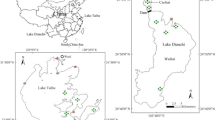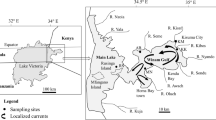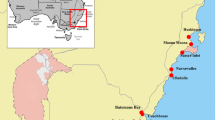Abstract
Arsenic concentrations were measured in aquatic invertebrates, macrophytes, sediments, and water of lakes in the vicinity of Yellowknife (N.W.T.), Canada. In arsenic-contaminated lakes the arsenic concentration ranged from 0.70 to 5.5 ppm in water, 6 to 3,500 ppm in bottom sediments, 150 to 3,700 ppm in macrophytes, 700 to 2,400 ppm in Zooplankton, and <1 to 1,300 ppm in other invertebrates. The arsenic concentration in invertebrates varied with sampling time, place, and taxon. Arsenic concentration factors were calculated, and found to decrease with increasing concentration of arsenic in ecosystem components of the lake. No evidence was found for biomagnification of arsenic through ascending trophic levels. In high-arsenic lakes herbivores had the highest arsenic concentrations, and omnivores the lowest. Pelecypoda, Ephemeroptera, Amphipoda, and Hirudinea were conspicuously absent from high-arsenic lakes. These particular organisms may be more susceptible to the effects of arsenic than others.
Similar content being viewed by others
References
Allen, R. J., E. M. Cameron, and C. C. Durham: Lake geochemistry; a low sample density technique for reconnaissance geochemical exploration and mapping of the Canadian Shield. Presented at the Fourth International Geochemical Exploration Symposium. London, England: April (1972).
Armstrong, F. A. J., and A. L. Hamilton: Pathways of mercury in a polluted Northwestern Ontario lake. In P. C. Singer (Ed.): Trace Metals and Metal Organic Interactions in Natural Waters, p. 152, Ann Arbor, Michigan: Ann Arbor Science Publishing Inc. (1973).
Ayers, John C: Lake Michigan environmental survey. Great Lakes research division.The University of Michigan. Spec. report no. 49 (1970).
Bérubé, Y., M. Frenette, R. Gilbert, and C. Ankil: Studies of mine waste containment at two mines near Yellowknife, N.W.T., Canada.Department of Indian Affairs and Northern Development, ALUR 72-73-32, (IAND Publication No. QS-3038-OOO-EE-Al) (1972).
Boyle, R. W.: The geology, geochemistry, and origin of the gold deposits of the Yellowknife District.Geol. Surv. Canada, Memoir 310 (1960).
Brunskill, G. J., and D. W. Schindler: Geography and bathymetry of selected lake basins, Experimental Lakes Area, Northwestern Ontario. J. Fish. Res. Bd. Canada29, 139 (1971).
Brunskill, G. J., D. M. Rosenberg, N. B. Snow, G. L. Vascotto, and R. Wagemann: Ecological studies of aquatic systems in the Mackenzie-Porcupine drainages in relation to proposed pipeline and highway developments.Canada Task Force N. Oil Dev. Env. Comm. Report 73-41, Vol. II. Appendices.Information Canada Cat. No. R-72 10073/1-2. QS-1533-020-EE-Al (1973).
Buchanan, D. W.: Toxicity of arsenic compounds, p. 155. New York: Elsevier Publ. Co. (1962).
Chapman, H. W., H. L. Fisher, and M. W. Pratt: Concentration factors of chemical elements in edible aquatic organisms.Lawrence Radiation Laboratory, University of California, Livermore, UCRL-50564. Distributed by:National Technical Information Service, U.S. Department of Commerce, 5285 Port Royal Road, Springfield, Va. 22151 (1968).
Dreisbach, Robert H.: Handbook of poisoning; diagnosis and treatment. 6th ed., pp. 168–191. Los Altos, California: Lange Medical Publications (1969).
Environmental Protection Service: Review of proposed sewage disposal to Kam Lake, N.W.T.Environ. Can. Environ. Prot. Serv. Rep. EPS8-NW-75-1 (1975).
Falk, M. R., M. D. Miller, and S. J. M. Kostiuk: Biological effects of mining wastes in the Northwest Territories. Technical Report Series No. CEN/T-73-10.Department of the Environment, Fisheries and Marine Service, Fisheries Operations Directorate, Central Region (1973a).
Falk, M. R., M. D. Miller, and S. J. M. Kostiuk: Data supplement to: Biological effects of mining wastes in the Northwest Territories. Data Report Series CEN/D-73-1.Department of Environment, Fisheries and Marine Service, Fisheries Operations Directorate, Central Region (1973b).
Handbook of Geochemistry. II-1, pp. (33-B-1)–(51-0-1), ed. by K. H. Wedepohl. Berlin: Springer-Verlag (1969).
Healey, M. C., and W. L. Woodall: Limnological surveys of seven lakes near Yellowknife, Northwest Territories,Environment Canada, Fisheries and Marine Service, Technical Report No. 407 (1973).
Henderson, J. F., and I. C. Brown: Yellowknife, Northwest Territories.Geol. Surv. Canada. Paper 52-24 (1952a).
Henderson, J. F., and I. C. Brown: The Yellowknife Greenstone Belt.Geol. Surv. Canada. Paper 52-28 (1952b).
Jackson, Robert G.: Factors influencing the distribution of trace elements in lake sediments, Yellowknife, N.W.T. Report No. 6.Department of Geological Sciences, Queen's University, Kingston, Ontario (1974).
Johnson, David L.: The simultaneous determination of arsenate and phosphate in natural waters. Environ. Sci. and Tech.5 411 (1971).
Kapp, John F., and Robert C. Kroner: Trace metals in waters of the United States, p. 31, U.S.Department of the Interior, Federal Water Pollution Control Administration, Division of Pollution Surveillance, 1014 Broadway, Cincinnati, Ohio 45202 (1970).
Lafleur, P. D.: Standard reference materials for the determination of trace elements in environment samples, In: Proceedings of a symposium on nuclear techniques in comparative studies of food and environmental contamination, pp. 489–496. Vienna:International Atomic Energy Agency (1974).
Lancaster, R. J., M. R. Coup, and J. W. Hughes: Toxicity of arsenic present in lakeweed. New Zealand Veterinary Journal19, 141 (1971).
Magnuson, H. J., and E. B. Watson: Microdetermination in biological materials. Ind. Eng. Chem. Anal. Ed.16, 339 (1944).
Nickerson, D.: An account of a lake sediment geochemical survey conducted over certain volcanic belts within the Slave, structural Province of the Northwest Territories during 1972.Geol. Surv. Canada, Open File, 129 (1972).
Onishi, H.: Arsenic. In K. H. Wedepohl (Ed.): Handbook of Geochemistry. II-1, Sec. 33:B1-05. Berlin: Springer-Verlag (1969).
Peoples, S. A.: Review of arsenical pesticides, In E. A. Woolson (Ed.): Arsenical Pesticides. ACS Symposium Series #7, Washington, D.C. (1975).
Portmann, J. E., and J. P. Riley: Determination of arsenic in sea water, marine plants and silicate and carbonate sediments. Anal. Chim. Acta31, 509 (1964).
Reay, P. F.: The accumulation of arsenic from arsenic-rich natural waters by aquatic plants. J. Appl. Ecol.9, 557 (1972).
Rudolfs, W., G. E. Barnes, G. P. Edwards, H. Heukelekian, E. Hurwitz, C. W. Renn, S. Steinberg, and W. F. Vaughan: Review of literature on toxic materials affecting sewage treatment processes, streams and B.O.D. determinations. Sewage and Industrial Wastes22, 1157 (1950).
Schneider, R. F.: The impact of various heavy metals on the aquatic environment. p. 22,USEPA, Water Quality Office Techn. Report No. 2 (1971).
Speyer, Menno, and Gerard Leduc: Effects of arsenic trioxide on rainbow trout. Paper presented at Intern. Conf. on Heavy Metals in the Environ., Toronto, Canada, October 27—31, 1975 (1975).
Surber, E. W., and O. L. Meehean: Lethal concentrations of arsenic for certain aquatic organisms. Trans Am. Fish. Soc.61, 225 (1931).
Turekian, K. K.: The oceans, streams and atmosphere. In K. H. Wedepohl (Ed.): Handbook of Geochemistry. I. pp. 297–323. Berlin: Springer-Verlag (1969).
Uthe, J. F., and E. G. Bligh: Preliminary survey of heavy metals contamination of Canadian freshwater fish. J. Fish. Res. Bd. Canada28, 786 (1971).
Vijan, P. N., and G. R. Wood: An automated submicrogram determination of arsenic in atmospheric participate matter by nameless atomic absorption spectrophotometry. Atomic Absorption Newsletter 13 (No. 2, Mar.–Apr.) 33, (1974).
Wallace, R. R., and M. J. Hardin: Chemical and biological characteristics of seepages from tailings areas at Cominco Con Mine into Kam Lake, Northwest Territories in 1974. Surveillance Report EPS5-NW-75-3.Northwest Region, Department of the Environment, Environment Canada (1975).
Wallace, R. R., M. J. Hardin, and R. H. Weir: Toxic and chemical characteristics of mining effluent in the Northwest Territories. Surveillance Report EPS5-NW-75-4.Northwest Region, Department of the Environment, Environment Canada (1975).
Woolson, E. A.: Bioaccumulation of arsenicals. Symp. Ser. 7, (Arsenical Pesticide Symp. 1974) (1975).
Author information
Authors and Affiliations
Rights and permissions
About this article
Cite this article
Wagemann, R., Snow, N.B., Rosenberg, D.M. et al. Arsenic in sediments, water and aquatic biota from lakes in the vicinity of Yellowknife, Northwest Territories, Canada. Arch. Environ. Contam. Toxicol. 7, 169–191 (1978). https://doi.org/10.1007/BF02332047
Received:
Accepted:
Issue Date:
DOI: https://doi.org/10.1007/BF02332047




